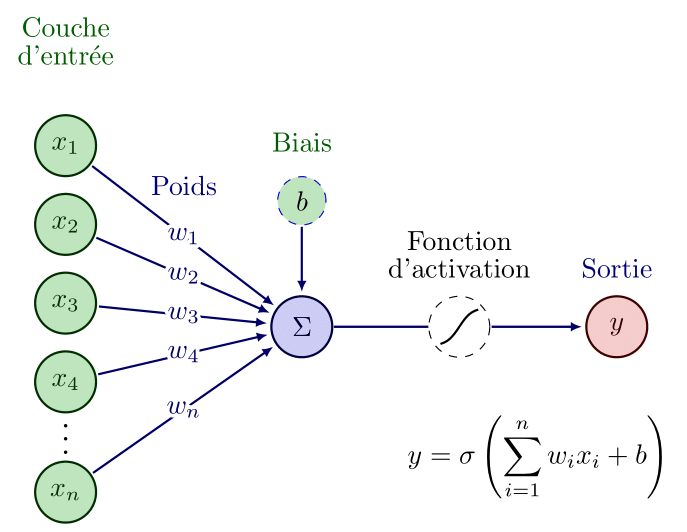Artificial neuron
Basic unit of neural networks

\documentclass[border=3pt,tikz]{standalone}
\usepackage{amsmath} % for aligned
\usepackage{listofitems} % for \readlist to create arrays
\usetikzlibrary{arrows.meta} % for arrow size
\usepackage[outline]{contour} % glow around text
\contourlength{1.4pt}
% COLORS
\usepackage{contour} % glow around text
\contourlength{1.4pt}
\usepackage[dvipsnames]{xcolor}
\usepackage{pgfplots}
\definecolor{taupegray}{rgb}{0.55, 0.52, 0.54}
\usepackage{neuralnetwork}
\usepackage{tikz-network}
\usepackage{xcolor}
\colorlet{myred}{red!80!black}
\colorlet{myblue}{blue!80!black}
\colorlet{mygreen}{green!60!black}
\colorlet{myyellow}{yellow!60!white}
\colorlet{myorange}{orange!70!red!60!black}
\colorlet{mydarkred}{red!30!black}
\colorlet{mydarkblue}{blue!40!black}
\colorlet{mydarkgreen}{green!30!black}
\colorlet{mydarkyellow}{yellow!30!black}
\tikzset{
>=latex, % for default LaTeX arrow head
node/.style={thick,circle,draw=myblue,minimum size=22,inner sep=0.5,outer sep=0.6},
node in/.style={node,green!20!black,draw=mygreen!30!black,fill=mygreen!25},
node hidden/.style={node,blue!20!black,draw=myblue!30!black,fill=myblue!20},
node convol/.style={node,orange!20!black,draw=myorange!30!black,fill=myorange!20},
node out/.style={node,red!20!black,draw=myred!30!black,fill=myred!20},
connect/.style={thick,mydarkblue}, %,line cap=round
connect arrow/.style={-{Latex[length=4,width=3.5]},thick,mydarkblue,shorten <=0.5,shorten >=1},
node 1/.style={node in}, % node styles, numbered for easy mapping with \nstyle
node 2/.style={node hidden},
node 3/.style={node out}
}
\def\nstyle{int(\lay<\Nnodlen?min(2,\lay):3)} % map layer number onto 1, 2, or 3
\begin{document}
\begin{tikzpicture}%[x=2.7cm,y=1.6cm]
\message{^^JNeural network activation}
\def\NI{5} % number of nodes in input layers
\def\NO{1} % number of nodes in output layers
\def\yshift{0.4} % shift last node for dots
% INPUT LAYER
\foreach \i [evaluate={\c=int(\i==\NI); \y=\NI/2-\i-\c*\yshift; \index=(\i<\NI?int(\i):"n");}]
in {1,...,\NI}{ % loop over nodes
\node[node in,outer sep=0.6] (NI-\i) at (0,\y) {$x_{\index}$};
}
% OUTPUT LAYER
\node[node hidden]
(NO) at (3,-2*\yshift) {$\Sigma$};
\foreach \j [evaluate={\index=(\j<\NI?int(\j):"n");}] in {1,...,\NI}{ % loop over nodes in previous layer
\draw[connect arrow,white,line width=1.2] (NI-\j) -- (NO);
\draw[connect arrow] (NI-\j) -- (NO)
node[pos=0.50] {\contour{white}{$w_{\index}$}};
}
% \fi
% DOTS
\path (NI-\NI) --++ (0,0.8+\yshift) node[midway,scale=1.2] {$\vdots$};
\node[dashed, circle,draw=myblue,fill=mygreen!25]
(NB) at (3,2*\yshift) {$b$};
\draw[connect arrow] (NB) -- (NO);
\node[dashed,circle,draw=black,minimum size=22] (activation) at (5,-2*\yshift) {};
%\path (NO-\NO) --++ (0,1+\yshift) node[midway,scale=1.2] {$\vdots$};
\begin{scope}[shift={(5,-2*\yshift)},scale=0.08]
\draw[thick] (0,0) plot[domain=-3:3] (\x,{6/(1 + exp(-1*\x))-3});
\end{scope}
\draw[connect] (NO) -- (activation);
\node[node out] (output) at (7,-2*\yshift) {$y$};
\draw[connect arrow] (activation) -- (output);
\node[above=0.5,align=center,mygreen!60!black] at (NI-1.90) {Couche\\[-0.2em]d'entrée};
\node[above=0.5,align=center,mygreen!60!black] at (NB) {Biais};
\node[above=0.5,align=center,myblue!60!black] at (output) {Sortie};
\node[above=0.5,align=center,black] at (activation) {Fonction\\[-0.2em]d'activation};
\node[above=0.75,align=center,myblue!60!black] at (1.5,0) {Poids};
\node[below=1,align=center ] at (6,-2*\yshift) {$\begin{aligned}
y=\sigma\left(\sum_{i=1}^n w_i x_i +b\right)
\end{aligned}$};
\end{tikzpicture}
\end{document}